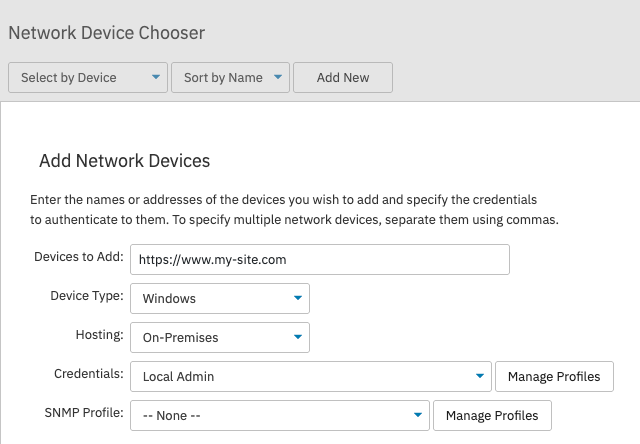The SSL Certificate Event Monitor checks the certificate on a secure web server and alerts if there are any problems with it. Potential problems include invalidity and expiry. This event monitor will alert you in the case of a missing certificate and also keep track of the expiry date of any current certificates.
To begin setting up your SSL Certificate Event Monitor, use the device chooser to select the sites you want to monitor. Select the website's URL, not the IP address or its host server. You may need to click "Add New" and enter the URL of your site in the "Devices to Add" text box. Once you have added and selected the site you would like to monitor, it's time to customize the SSL Event Monitor's settings.
 Adding a Site by URL
Adding a Site by URL
One important feature of the SSL Certificate Event Monitor is that it can alert you as soon as it notices a missing certificate. This way, if any of your sites' certificates are removed, you will be alerted as soon as the event monitor detects it. The next option will alert you if any of your certificates have expired.
 Certificate Settings
Certificate Settings
This event monitor has an option to notify you if the certificate will expire in less than a specified number of days, giving you time to renew them before they ever expire. Enter the number of days before expiry that you want to be notified. You can specify different days to receive an info, warning, error, or critical level alert. The option also exists to be alerted if the certificate will expire in more than a specified number of days.
 Expiry Settings
Expiry Settings
The SSL Certificate Event Monitor connects to your sites in the same way a browser would. The "Connection Time Out" option lets you specify the amount of time the event monitor will spend trying to connect to the web server. The "Receive Time Out" option lets you specify the amount of time the event monitor will spend waiting for a response back from the web server. Leaving these values at their default will most often be preferable, but the option exists to modify them.
 Time Out Settings
Time Out Settings
The default port number for connecting with SSL is 443, but you may need to change it if the site you're monitoring uses a non-standard port number.
The SSL Certificate Event Monitor is crucial for staying on top of the expiration dates of the certificates on your websites. This tutorial taught you how to set one up, including how to correctly add your sites and schedule reminders to renew your certificates. Refer to our SSL Certificate Event Monitor reference guide for more documentation on this event monitor. Keep an eye out for new tutorials coming to the Features page soon!
More IT Monitoring Features